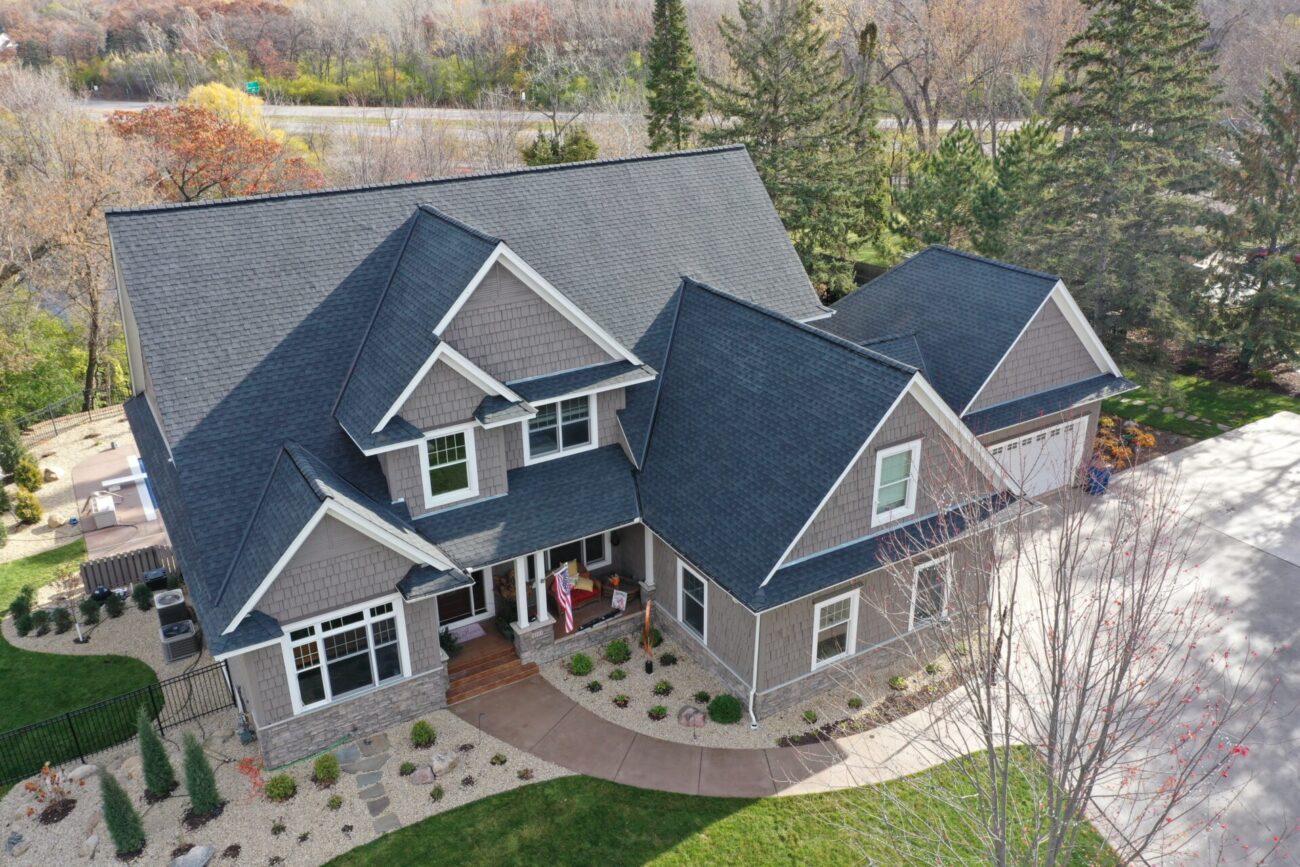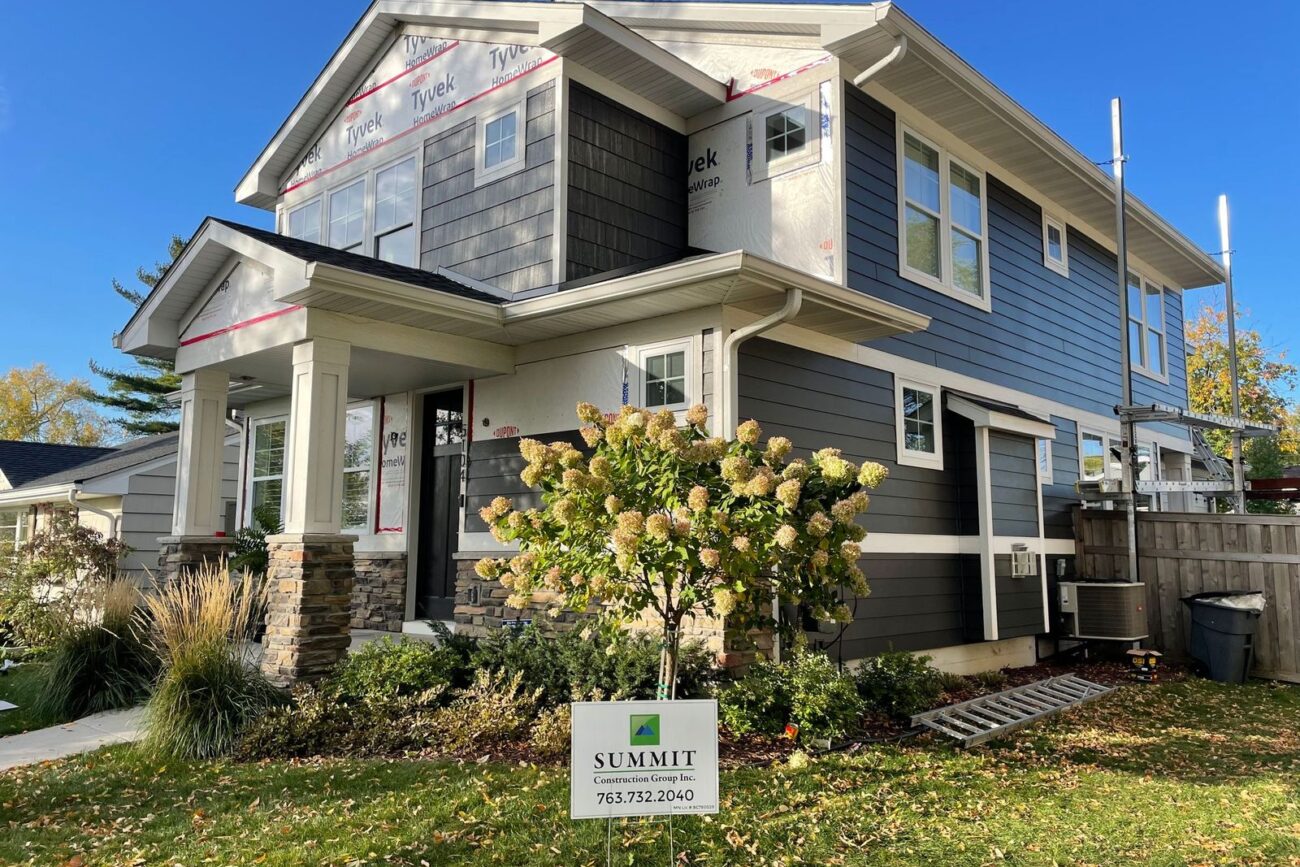Minnesota winters are not just cold, they’re punishing. And when the wind bites and the mercury plummets to -10, it’s your home’s siding that stands between you and sky-high heating bills. That dreadful feeling when you open a utility bill and realize your home is hemorrhaging money in energy costs? We’ve all been there.
The good news: Energy-efficient siding is one of the most powerful things you can do to lower energy consumption, increase comfort, and protect your home for decades. Energy efficient siding acts as a thermal shield, helping Minnesota homeowners combat harsh winters while cutting down on energy waste.
If you’re building a new home or upgrading an older home, we’re here to break it all down: what makes siding energy-efficient, which materials perform best, and how to choose the right system for Minnesota’s punishing climate.
What Is Energy-Efficient Siding?
When it comes to energy efficiency, not all siding is created equal. Energy-efficient siding refers to any exterior cladding system that is designed to improve your home’s thermal envelope. In other words, it’s your home’s ability to retain heat in the winter and keep that heat out in the summer.
Efficient siding options reduce heat transfer through your walls, block drafts, and act as a thermal barrier between the elements and your living space. The result? Lower heating and cooling bills, more consistent indoor temperatures, and a smaller carbon footprint. Think of it as a warm winter jacket for your home. And as an added perk, modern eco-friendly siding choices combine sustainable materials with advanced insulation to deliver both style and savings, making them good for both you and the environment.
How Does Insulated Siding Work?
The key to insulated siding is… well, the insulation. Insulated siding is typically backed with rigid foam insulation, which is a layer of expanded polystyrene (EPS) or similar material that is fused to the back of the panel. While it may not look like much, this foam layer does more than add bulk, it minimizes thermal bridging, which is the process by which heat escapes through wall studs and framing. It does this by breaking up the pathways that allow this to happen. Installing siding with foam backer improves thermal bridging resistance and strengthens your home’s exterior envelope.
Insulated siding helps maintain consistent indoor temperatures, especially when paired with attic insulation and energy-efficient windows. This can significantly improve the overall R-value of your walls, helping to reinforce the entire home envelope.
The Best Energy-Efficient Siding Materials
Not all siding is created equal. Here’s a list of some of the top-performing materials, which offer the best thermal performance, moisture resistance, and cold-weather durability. And remember, choosing the right energy efficient siding material depends on your climate, budget, and whether you’re doing a retrofit or a full remodel.
So it’s best to keep in mind that homeowners in northern climates should prioritize thermal performance siding to maintain consistent indoor temperatures during extreme cold spells.
Energy‑Efficient Siding Comparison
Table compares siding materials for cold-climate performance, R-value, maintenance, and use cases.
| Material | Typical Added R‑Value | Cold‑Climate Performance | Moisture / Wind | Maintenance | Cost* | Best For | Notes |
|---|---|---|---|---|---|---|---|
| Insulated Vinyl (foam‑backed) | R‑3 to R‑4 | Excellent draft reduction; helps limit thermal bridging | Good with proper flashing & housewrap | Low | $$ | Retrofits & budget‑friendly upgrades | Big efficiency gain vs. standard vinyl; many colors/textures |
| Fiber Cement + Continuous Foam | ~R‑5+ (system) | Stable in freeze‑thaw; very durable | Strong in wind; resists swelling/cracking | Low | $$$ | Long‑term durability in harsh climates | Use rigid foam/housewrap to boost envelope performance |
| Engineered Wood (with foam backer) | ~R‑2 to R‑3 (system) | Warm look with solid thermal bump | Good when installed per spec | Low–Medium | $$$ | Eco‑minded curb appeal | Natural insulation + option to add continuous exterior foam |
| Insulated Metal Panels | ~R‑4 to R‑7 (panel) | Strong thermal barrier; modern aesthetics | Excellent wind & moisture control | Low | $$$–$$$$ | Modern designs, passive/solar‑friendly builds | Less common in residential; verify compatibility/details |
| Standard Vinyl (non‑insulated) | ~R‑0.6 | Minimal thermal benefit | Fair; relies on housewrap details | Low | $ | Tight budgets, future upgrade path | Add foam sheathing to meaningfully improve efficiency |
*Cost key: $ = least expensive, $$$$ = most expensive. Actual pricing varies by brand, profile, and installation complexity.
Vinyl Siding with Foam Backing
Vinyl siding with foam insulation panels is one of the most popular insulated siding options on the market. It’s lightweight, budget-friendly and easy to install, especially in retrofits. Vinyl insulation panels add both thermal resistance and noise reduction.
- R-value of siding materials: R-3 to R-4
- Good at reducing drafts and improving exterior wall insulation solutions
- Comes in a variety of colors and textures
Fiber Cement Siding with Insulation
While regular fiber cement has very little insulating ability, fiber cement siding with added foam board or house wrap can be a high-performance solution. Known for its durability and fire resistance, adding insulation to fiber cement siding can make a huge difference:
- Performs well in humid or windy conditions
- Does not crack or swell in freeze-thaw cycles
- Great for energy efficient home upgrades that last
Note that fiber cement siding energy efficiency improves dramatically when installed with continuous insulation like rigid foam board.
Read More: 6 Reasons Why Hardie Board Siding is a Top Choice for Homeowners
Engineered Wood and Composite Siding
Engineered wood and composite siding are more sustainable siding options. They provide the look of natural wood but with better moisture and insect resistance.
Engineered wood also provides natural insulating properties, making it a great option for environmentally conscious homeowners.
- Can be paired with foam backers to increase R-value
- Reduces heating costs with functional and beautiful siding
Insulated Metal Siding
While not a typical residential building material, insulated metal siding is increasing in popularity in commercial-style and modern homes. It features a reflective surface and a foam core, both of which deflect heat and insulate the home at the same time.
- Excellent thermal barrier siding solutions
- Durable and low-maintenance
- Complements solar or passive home designs well
Siding Considerations for Minnesota Homes
When it comes to choosing the best siding for cold climates, especially in Minnesota, the biggest considerations are temperature fluctuations, moisture, and wind.
We recommend siding that:
- Does not crack, warp, or shrink at subzero temperatures
- Comes with built-in or added foam insulation to avoid cold spots and ice dams
- Is up to the current Minnesota energy code siding standards
- Can integrate well with other home upgrades like triple-pane windows and attic insulation
Selecting high-efficiency, reduced heating costs siding can shave hundreds off your utility bills during Minnesota’s long winters.
R-Value: What You Need to Know for Your Siding
R-value measures how well a material resists the flow of heat. The higher the R-value, the better the insulation.
Here’s a quick breakdown of R-values for various siding options:
- Standard vinyl siding: R-0.6
- Insulated vinyl siding: R-3 to R-4
- Fiber cement with added foam board: R-5+
You’ll get the best bang for your buck when you combine materials (for example, siding with a high-density foam underlayment) to create a layered insulation effect. You can dramatically increase the performance of your home envelope insulation without any interior renovations.
And note that modern thermal barrier siding systems are designed to block conductive heat transfer, helping homes retain warmth more efficiently.

Long-Term Savings & Utility Bill Impact
When it comes to long-term savings, investing in energy-efficient siding is one of the best things you can do for your home.
- Energy-efficient siding can offer homeowners: 10-20% annual energy savings. There are many types of siding that lowers energy bills without compromising curb appeal, from vinyl to fiber cement.
- Potential for federal tax credits or local energy rebates.
- Reduced strain on your HVAC system, which can extend its life.
- Increases resale value in an increasingly eco-friendly housing market.
Energy-Efficient Siding Can Be Beautiful
Who said energy-efficient had to be boring? Today’s eco-friendly siding solutions are available in a wide variety of styles, textures and profiles, from classic lap siding to sleek modern panels. Eco-friendly options typically include:
- Recycled materials
- Low-VOC finishes
- Sustainable siding can mimic wood without the maintenance
- Improved curb appeal and architectural character
Is It Time to Upgrade Your Home Siding?
Does your home’s siding have any of these warning signs that it’s time to upgrade?
- Drafts near walls or windows
- Cracked, peeling, or loose panels
- Sky-high heating bills every winter
Of course, you don’t have to go for a full replacement. Retrofitting with insulated vinyl or foam-backed panels can offer substantial gains, too.
Summit Construction’s team can assess your current siding and recommend the best energy-saving home upgrades based on your climate, budget, and design goals. We want to help you find the right solution to lower your heating costs and increase comfort all year long, whether you just want a subtle refresh or a full thermal performance overhaul. Contact us to see how we can help you and your home.
Read More: What is the Most Energy Efficient Roof?
Lower Your Heating Bills with Energy-Efficient Siding
Minnesota winters are not going anywhere. But your energy bills can change. By investing in energy-efficient siding, you’re not only improving comfort for the whole family but also boosting your home’s performance, sustainability, and resale value. From R-value to thermal barrier siding solutions, the right siding is a powerful ally in the fight against the cold.
Want to take the next step? Request a quote from Summit Construction to explore top-performing, Minnesota-approved siding solutions custom-tailored to your home. With Summit’s expert guidance, finding the right energy efficient siding solution for your home is easier than ever.
Still have questions? Our siding FAQs have you covered. Or if you want to take a look at some of the featured projects, just click here. With the right materials and the right team, energy efficiency is just one smart renovation away.


